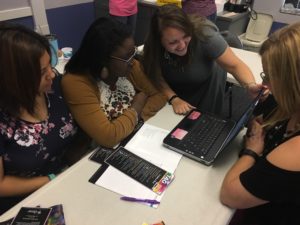By Maina Cisneros; first published by The 74, June 19, 2017

For years, my school, Washington Elementary in Big Spring, Texas, struggled to meet all our students’ literacy needs. We group students in tiers, as in the “Response to Intervention” model, but each year we were still left with extremely large groups in Tier II and Tier III — struggling students and chronically struggling students. Each year, we tried to reinvent the wheel to increase our student success, but to no avail — until last year.
Most of Washington’s students come from low-socioeconomic-status households. Several have grandparents or someone other than parents raising them, several come to school hungry and dirty, many have parents who work multiple jobs and cannot help with homework, and quite a few have at least one parent in prison. When small children are forced to deal with situations like these, school often takes a back seat. Nevertheless, my co-workers and I must make sure they receive a quality education.
That’s when I saw the value of my new role as a multi-classroom leader. As an MCL, I no longer had my own classroom all day; instead, with the time to co-plan, collaborate, co-teach, and track and analyze students’ data, I could lead my teaching team in using strategic student placement and monitoring to finally find success.
Last year I worked primarily with first-graders. My goal was to help kids read on grade level. That was crucial to get right in first grade because year after year we found that several of our students had reading fluency issues; these interfered with their ability to comprehend what they read and eventually stymied them when they hit third grade, the first time they faced state tests.
But just reading on level was going to be a difficult task. As I analyzed the data, I realized that we had 31 students reading on an appropriate level for first grade, 15 students who were almost where they needed to be (Tier II), and then a whopping 39 students well below the recommended reading level for first grade. Something needed to change!
Time never seems to be a teacher’s friend — here it proved our biggest barrier. My team and I were already pulling out small groups of students, knowing this would lead to better results, but we had nowhere near enough time in the day to meet each student’s needs, even with our daily hour for interventions. My fellow teachers, paraprofessionals, and I pulled students back to meet in small groups or even one-on-one, but with so many below level, we needed more time. I was worried, because although we were seeing some growth among our kids, I knew there was a great deal of work to be done.
Finally, I had an aha moment! We had to unchain ourselves from our one-teacher-one-classroom setting. To get small groups of students with a teacher as much as possible, we needed to consider the entire first grade as one class. Using our student learning data, I put students into groups based on ability only — meaning they would not necessarily be with their own classmates or their classroom teacher. The students needing reading fluency intervention would have more time to work in a small group with an assigned first-grade teacher — for a whole hour instead of 15 to 20 minutes, each day.
I couldn’t wait to share this idea with my teachers for feedback, but I was also nervous about their possible resistance — or the plan’s failure. After all, this restructuring of intervention time was something totally different from the way we had been doing things.
However, the team agreed that our intervention time was lacking, and they were willing to try something new. Because an Opportunity Culture® includes extended planning time for MCL teams, we also agreed to reserve a block of that time to tweak interventions and have in-depth conversations about each student receiving intervention. This meant the teachers who shared students, and I as their MCL, could focus on individual issues to better guide those students to success. Having an MCL was crucial here, because I had been in all classrooms and knew the needs of all our students. My broad grasp plus my own data analysis could be used to help ensure success for our kids.
Where did this get us? Let’s go back to the data: Based on reading fluency, we dropped from 39 to 28 Tier III students and from 15 to 7 Tier II — and went up from 31 Tier I students to 53! Yes, we have to continue that focus on the struggling students, but after so many years of struggling ourselves, we were thrilled with our results.
This sounds like a simple fix, and maybe an obvious one. But without the MCL role on our team, I’m not sure we would have been able to look over the data we needed to, in depth, or if my teachers would have felt comfortable using an out-of-the-box approach to intervention.
We want teachers to be innovative, but with all that a classroom teacher has tugging at her, the time and space to think that way can be tough to find. And because I’m accountable for our students’ results, my team could trust that I felt confident in this approach and wasn’t putting their roles at risk. Having an MCL in place opened us up to innovation — and, I’m pleased to note, it spread throughout the school.
Maina Cisneros is the second-grade multi-classroom leader at Washington Elementary in Big Spring, Texas, the first rural Opportunity Culture® district. Read more columns written by Opportunity Culture® educators, many with accompanying videos, here.
Note: Public Impact® and Opportunity Culture® are registered trademarks; Multi-Classroom Leader® and MCL™ are trademarked terms, registration pending.
